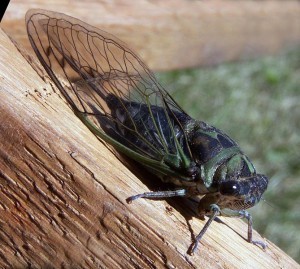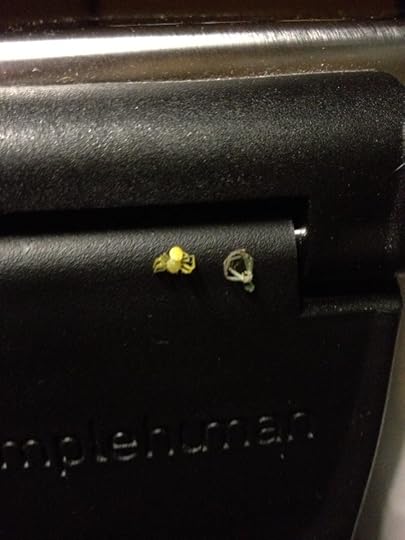Bathroom Readers' Institute's Blog, page 171
April 20, 2013
Freaky Video: Huge Spider Sheds Skin
This video gave us chickenbumps! (The bumps store was all out of geese.)
Bonus: This post is another exciting entry in the Uncle John’s Bathroom Reader exclusive: Great Moments in Weird Background Music. Because the background music in that video is cracking us up.
Note: This post was inspired by the lovely and curious Mrs. BRI T., Christine, who took a photo of a tiny bright yellow spider at her workplace that seemed to have shed her skin. We were not aware that spiders shed their skins – they do! – and research on the issue led to that video! Thank you, Christine!
Tiny bright yellow spider:
April 17, 2013
Free National Park Week, 2013
An Uncle John’s Bathroom Reader PSA: Every National Park in the U.S. has free admission this coming week!
From our National Park Service:
Did you know that National Park Week is April 20-28, 2013?
Did you know that there are 401 national parks? That they include seashores, battlefields, historic homes, archeological sites, and spectacular natural areas?
Did you know there is at least one national park in every state? …
You can plan your visit by what you want to do, or where you want to go … or you can browse our event calendar and check out the special programs offered that week. Also, from Monday through Friday, April 22 to 26, every national park will have free admission!
Free admission—that’s a big savings if you go to a park with your family or a group of friends, just to note. Also, visit www.nationalparks.org for more resources for this years free national park week.
And if you need a bit of a guidebook—we have a whole book on National Parks! (No way! What a coincidence!)
Some of the scintillating subjects you’ll find in this volume:
Yosemite’s firefall and why it came to a sudden end
How to avoid bear attacks, buffalo stampedes, and moose on the loose
Ghosts, legends, and myths in the remotest parks of the country
The wild horses of Assateague and why they still roam the island
How an isolated tree in Yosemite inspired the most famous photograph of all time
The history of Ellis Island National Park
And a bunch more!
It’s available as an eBook too! (You’ll have to scroll down a bit to find it!)
That is all! Have a wonderful day! And we hope you can get to enjoy this years free national park week!
April 14, 2013
Best Golf Book EVER
Masters UPDATE: Adam Scott – WHAT. A. PUTT. Wow.
And now holy cow, Angel Cabrera. What a finish coming up…
Congratulations, Adam Scott and Australia! Wow! What a finish! (And Angel Cabrera – you are a class act. Nicely done! And very nice of Scott to give a nod to The Shark. All around very nice day of golf.)
***
Hey, did you know you can get your favorite golf fan the best book on golf ever made! No, not that one – this one!
Check out this review at Amazon:
Every year for Christmas, I get my husband an Uncle John Bathroom Reader – as the throne room IS his favorite place to read. He is a golfer, too. THIS book has to be one of the funniest since the laughter floating out the bathroom door was just plain fun to listen too. Later on or days later on the golf course, he would be sharing the stories he read and the laughter would begin again.
This year, I gave him a new padded toilet seat for his throne and 3 Uncle John Readers! I do believe it was one of the best choices I’ve ever made as far as gifts go…especially on the grin and giggle meter!! Thanks, Amazon for having the best choices.
And it’s not just humor, check out this sample:
•
•
You can get it in three different eBook versions, too! (Scroll down a bit to find this book.)
That is all! Enjoy!
April 11, 2013
Beaver Kills Man (and video)
Horrific news out of Belarus today:
The Belarus man was on his way to a lake with some friends when, according to a report by the U.K. Telegram, they spotted one of the normally gentle animals on the side of a road and attempted to take a photo.
According to the U.K. Telegraph report the fisherman was bitten in the thigh several times – severing an artery. Although first aid was administered and an ambulance called the man died from blood loss.
Wow. Not the kind of news you hear every day. And to back up the story, at the link we provided they have this video, which they say is “a recent unrelated video was also posted to YouTube involving a beaver atttack.” And it just might give you nightmares:
Note to Self: When traveling in Eastern Europe, if you come across a semi-aquatic, large-toothed, xylophagous rodent…run away. Don’t ask…just run away.
• The Eurasian beaver. They’re a bit different – and larger – than their North American cousins, just to note.
• Image from here.
Big Noise, Little Bug: The Cicadas are Coming!
As the East Coast prepares for the cicadas invasion due sometime in the next month, we dig in our vault to find some more information about this tiny, yet noisy bug. The following article is from Uncle John’s Fully Loaded Bathroom Reader.
BIG NOISE, LITTLE BUG
Cicadas are the vuvuzelas of the insect world. (What are vuvuzelas? Those loud horns that nearly caused soccer fans’ brains to explode during the 2010 World Cup.) Vuvuzelas reach a decibel level of 60, but cicadas? These little bugs can reach a decibel level twice that loud.That’s as loud as a rock concert or a jet engine.
BROODY BUGS
 Cicadas are bizarre, especially the “periodical cicadas” that live only in eastern North America. What’s odd about them is that they’re on either a 13- or a 17-year cycle. They emerge in “broods” of so many bugs it’s like some shock-and-awe insect invasion, make a lot of deafening noise, mate, lay eggs, and, within just a few weeks, die. Then they disappear again for an another exact number—13 or 17—of years. Entomologists are still trying to figure out what makes periodical cicadas tick. The main problem: those long cycles. It’s difficult for scientists to study an insect that shows up only once or twice in their careers. The name cicada is Latin for “tree cricket,” which is actually incorrect: cicadas are not crickets. And though one species is commonly called the “17-year locust,” they’re not locusts, either. Locusts are “eating machines” that can devour entire crops. Cicadas don’t eat leaves; they’re sapsuckers, like their closest relatives leafhoppers and spittlebugs. Cicadas have also been called “jar flies,” “harvest flies,” and “dust flies,” but their Australian nickname, “galang-galang,” which echoes the racket they make, may be the most fitting.
Cicadas are bizarre, especially the “periodical cicadas” that live only in eastern North America. What’s odd about them is that they’re on either a 13- or a 17-year cycle. They emerge in “broods” of so many bugs it’s like some shock-and-awe insect invasion, make a lot of deafening noise, mate, lay eggs, and, within just a few weeks, die. Then they disappear again for an another exact number—13 or 17—of years. Entomologists are still trying to figure out what makes periodical cicadas tick. The main problem: those long cycles. It’s difficult for scientists to study an insect that shows up only once or twice in their careers. The name cicada is Latin for “tree cricket,” which is actually incorrect: cicadas are not crickets. And though one species is commonly called the “17-year locust,” they’re not locusts, either. Locusts are “eating machines” that can devour entire crops. Cicadas don’t eat leaves; they’re sapsuckers, like their closest relatives leafhoppers and spittlebugs. Cicadas have also been called “jar flies,” “harvest flies,” and “dust flies,” but their Australian nickname, “galang-galang,” which echoes the racket they make, may be the most fitting.
THE DROP ZONE
Periodical cicadas wait a long time for their 15 minutes of fame, spending the bulk of their lives hidden underground. Each cicada begins as one of about 600 eggs embedded into V-shaped slits that a female cicada makes into new growth at the tips of tree twigs. The female makes the grooves using the sharp proboscis (feeding tube) under her chin. (It’s the same tool cicadas stick into plant stems to suck out the sap, their main food.) The egg-laying process can cause the twig tips to turn brown but doesn’t harm adult trees. Saplings are a different story—too many cicada eggs can kill young trees. When cicada eggs hatch it’s kind of like a family riding the Drop Zone at an amusement park. After 6-10 weeks, baby cicadas emerge as “nymphs.” They look like the adults they’re going to become, except they’re smaller (about the size of an ant) and they can’t fly. That’s why a nymph’s intro to the cold cruel world is a sudden plummet from the tree to the ground below.
HIT THE GROUND RUNNING
After crash landing, cicada nymphs burrow into the ground, digging down 1 to 9 feet where they settle in next to a juicy root. They leach off the root for their entire 13 (or 17) years underground. During that time, periodical cicadas don’t cocoon, they molt. Over and over. They eat, their bodies grow, and when they grow too big for their skin: pop! Their exoskeletons burst open, and a slightly bigger and more mature cicada emerges. This happens seven times before they become adults. In the spring of their 13th (or 17th) years, the cicada’s biological alarm clock sounds. As for the time of year, many experts think soil temperature triggers cicada nymphs to emerge. When it reaches a constant minimum of 64° F or 18° C, cicadas burrow to the surface for the first time since they dropped from the tree at hatching. If the ground is wet, “mud chimneys” appear on the ground as the nymphs tunnel upward. If the ground is dry, the emerging cicadas leave it pockmarked with round holes. As soon as they reach the surface, cicadas scurry off to attach themselves to a plant (trees are particular favorites) for one final molt—this one will make them full-fledged adults. The skin down the middle of their backs splits open and the adult cicadas climb out, stretch their wings and wait for them to dry, and then fly off, leaving their empty skins hanging on the tree. (These look so much like live cicadas that they act as decoys for predators.) After about six days of hiding in leaves while their new outer shells harden, it’s time to start singing.
THAT “COME HITHER” FLICK
Cicadas have a pair of stiff hollow membranes called tymbals located on the sides of their abdomens just behind their wings. When they flex the large muscles attached to the tymbals, the tymbals buckle inward. This buckling makes a vibrating click that’s amplified by an air chamber in the insect’s abdomen. As the muscle relaxes, the tymbal sounds again. Repeating this action quickly and repeatedly can sound like anything from a motorbike to the vuvuzela-infested soccer stadium. The specific sound depends on the species of cicada. “Choruses” of male cicadas congregate in high tree branches, hoping to get lucky with a receptive female. The louder a cicada sings, the better its chance of attracting a mate. There are a lot of competitors: As many as 1.5 million cicadas can emerge in a single acre, but many of those are females whose biological clocks are ticking away the last few weeks of their lives. Females don’t call. When they hear the singer of their dreams, they signal their interest with an alluring flick of their wings.
CAN YOU HEAR ME NOW?
Every species has its own song. Differences in tymbal size between species create different tones, which combine with the speed of clicking and the length of the call to make up each species’ distinctive call. And like moms and elementary school teachers, cicadas have “selective hearing.” Each cicada species clearly hears its call while remaining virtually deaf to the calls of other species. Result: A dozen cicada species could be buzzing their tymbals off in a single forest, and each cicada would be able to pick out the call of its own species above the din. But cicadas are often fooled by machines: Because they can only hear one narrow range of frequency, odds are good that some undertone or overtone of machine noise will match it. The sounds of lawnmowers, weed whackers, and other chugging two-cylinder machinery can sound quite attractive to a female cicada. (“He’s playing our song.”)
NOT QUIET ON THE SOUTHERN FRONT
Although cicadas are Johnny One-Note when it comes to pitch, they can modulate it a bit. Once a male attracts a female with its “calling song,” it switches to a softer, more romantic “courtship song.” Cicadas also have a “distress call” that they use when caught by a predator: They click erratically like a tiny engine revving and stopping as it runs out of gas. How loud a chorus gets depends on the concentration of cicadas in a given area. The noise can be as loud as 88–120 decibels (from a blender to a jet engine). Brood XIX, a 13-year brood also known as the Great Southern Brood, was scheduled to emerge in May 2011. Spurred on by horror movielike headlines, people from Virginia to Oklahoma started to worry about whether the “deafening” insects that were about to cover their trees could actually make them deaf. Biology professor Johannes Schul offered reassurance: “It won’t damage anyone’s hearing, and won’t have any adverse health effects aside from stressing a few people out.” Don Griffith, a 70-year-old retired Georgia school superintendent experienced that stress first-hand during Brood XIX: “It sounds like a million little wooden boxes rattling with a million marbles. They’ll land on your collar. They’ll land on your head. It causes you to think maybe you’re at war with them.” Despite Griffith’s periodical cicada paranoia, those masses of insects really are fighting for something: survival.
SURVIVAL OF THE LUCKY
Many animal species hang out in herds, schools, or flocks. Why? Because there’s safety in numbers. Cicadas take this to an absurd length, coming out en masse, but not every year. Scientists theorize that if broods emerged every year, predator populations would be so well fed they’d increase. Every year, more and more predators would be standing around with their tongues hanging out, waiting for the cicadas to show up. Cicadas survive by going into hiding for so long that few individual predators live long enough to see the tasty bugs more than once in their lives. Brood X, also known as the Great Eastern Brood, is on a 17-year cycle and last showed up in 2004. This brood’s turf stretches from the Chesapeake Bay to the edge of the Great Plains. Scientists say the 2004 emergence was probably “the largest insect outbreak on Earth.” How large? It produced an estimated one trillion cicadas. Scientists call this natural strategy “predator satiation.” Predators that happen to be around gorged themselves until they can’t eat another insect. After a few days, predators get sick of eating cicadas and leave them alone. “If you walked outside and found the world swarming with Hershey Kisses, eventually you’d get so sick of Hershey Kisses that you’d never ever want to eat them again,” said biologist and editor-in-chief of American Entomologist, Gene Kritsky. Most cicadas survive and go on to sing, mate, and lay eggs (if they’re female) for about two weeks.
ON THE MENU
What eats cicadas? Just about any animal that isn’t a vegetarian: birds, foxes, wolves, dogs, cats, opossums, pigs, squirrels, frogs, lizards, fish, other insects…and people. Since pre-history humans have been eating cicadas either fresh off the tree, stir fried, deepfried, or roasted over fires. “They’re high in protein, low in fat, no carbs,” Kritsky told National Geographic News during the 2004 outbreak. “They’re actually quite nutritious.” (Female cicadas, by the way, have a reputation for being meatier and more succulent.) If being eaten after 13 or 17 years stuck underground seems unfair, it may be preferable to two other fates. First, the cicada’s most virulent enemy, Massospora cicadina. It’s a fungal disease to which these insects are particularly susceptible. Spores can infect cicadas when they’re still underground, resulting in malformed bodies and wings. Cicadas can also be infected as they emerge. If that happens, the infected individual’s abdomen swells up and breaks off, exposing a white, chalky mass of spores. This sterilizes the cicada but does not kill it; infected cicadas pass the fungus on to others as they try to mate, infecting them, too.
KILLER QUEENS
Frankly, if we were cicadas, our least preferred predator would be the second one: the giant (2″ long) cicada killer wasp (Sphecius speciosis). Instead of administering a quick death, the cicada killer queen swoops down and lands on an unsuspecting cicada. She administers a paralyzing sting, straddles the cicada, grasps it with her legs, and flies it to her underground nest, where she rolls the unlucky cicada into a cell, and lays an egg on it (if the egg is female, the wasp may provide two or three cicadas). Finally, she seals the cell to create a sort of climate-controlled incubator. Two to three days later, the egg hatches and the larva emerges to discover a juicy birthday breakfast. What makes this such a horrible death is that the cicada killer’s paralyzing sting keeps the cicada alive so that the larvae can dine on living flesh for 10-14 days, until only the cicada’s outer shell remains.
UNTIL WE MEET AGAIN
So, how does our cicada story end? With the entire brood dying off in a peaceful mass death like some insect Jonestown, leaving no survivors. (And predators wondering if that all-you-can-eat buffet was just some crazy dream.) From start to finish—from the time the first cicada nymph digs tunnels up until the final die-off—a brood’s above-ground life lasts about 4–6 weeks. “They come and go so quickly,” said University of Georgia entomologist Dr. Nancy C. Hinkle. But, at least we know one thing. “They’ll be back…”
A FEW FACTS
• There are at least 2,500 species of cicadas. Africa has about 450, Australia 200, North America at least 105, and the British Isles 1.
• Some tropical species grow to as long as 6 inches. Some desert species can sweat to cool themselves. (Very rare among insects.) Some cold-weather cicadas can raise their body temperatures at will by more than 70°. (Very rare among not just insects, but most living things.)
• With two large red compound eyes on the sides of the head and three small ocelli (simple eyes) in a triangle on the front of the head, periodical cicadas have excellent vision.
• In India, one cicada species is called the “World Cup Cicada.” It emerges in synch with the FIFA soccer tournament, held every four years from mid-June to mid-July. (Who needs vuvuzelas?)
• In China, cicada “flowers” (shells left behind after molting) are collected and used in traditional medicine. They’re a common ingredient in formulas used to cure fevers, sore throats, blurry vision, spasms, and skin irritations.
• Because of its extended life cycle, the 17-year cicada is the world’s longest-living insect.
• Most periodical cicadas have red eyes, but a small percentage have blue or white eyes. During the 2011 emergence of Brood XIX, which covers 15 states, word spread that researchers were paying $3,000 for specimens of blue-eyed cicadas, but according to Vanderbilt University biology professor Patrick Abbot, that was “a recurrent myth.”
• Scientists say its tough to understand the purpose of an insect as bizarre as the periodical cicada, but they do play positive roles: They are a food source for a wide variety of species. Their tunnels aerate the soil and aid tree growth. The twig damage caused by female egg-laying “prunes” trees and stimulates future growth.
• Periodical cicada nymphs that burrowed underground during the Clinton Administration will still be emerging until the year 2017.
• Because of the clearing of hardwood forests, several broods of periodical cicadas are now extinct.
• In 2004 University of Maryland grad-student Jenna Jadin put together a brochure called “Cicada-Licious: Cooking and Enjoying Periodical Cicada.” Recipes include El Chirper Tacos, Cicada Dumplings, Cica-Delicious Pizza, Banana Cicada Bread, and Cicada-Rhubarb Pie. (The brochure can be found online.)
April 10, 2013
Bad Ads You Might Have Missed
Last month, Ford Motors landed in hot water after a series of sexist advertisements it ran in India.
The three bad ads feature illustrations of Paris Hilton, former Italian prime minister Silvio Berlusconi, and German racecar driver Michael Schumacher each sitting in the front seat of a Ford Figo. In each ad, the celebrity had their “enemies” tied up in the trunk (to demonstrate how big it was). Hilton had paparrazi bound and gaggedl Schumaker had rival drivers. Berlusconi had a bunch of scantily clad models in his trunk.
Of course, this isn’t the first time an ad campaign has courted controversy. Last year, the makers of Pop Chips thought it would be hilarious to dress actor Ashton Kutcher up as “Raj,” a sleazy, thick-accented Bollywood producer and stick him in a commercial. Following an outcry on the Internet, the company yanked the bad ads. But here it is!
In spring of 2012, the Lung Cancer Alliance rolled out a series of bizarre posters arguing that nobody deserved to die of cancer, each people widely thought to be annoying, including “hipsters,” “crazy old aunts” and “cat people.” The ads, which the LCA hoped would lead people to its informational website, were a little too subtle, though, when people thought they were saying that those groups deserved to die. Many of the posters were torn down in several cities, presumably by hipsters, crazy old aunts, and cat lovers.
April 8, 2013
Funny Hall of Fame: ‘Poodles’ are Actually Coiffed Ferrets on Steroids
 Move over, old Funny Hall of Fame, there’s a new kid (ferret) in town:
Move over, old Funny Hall of Fame, there’s a new kid (ferret) in town:
Gullible bargain hunters at Argentina’s largest bazaar are forking out hundreds of dollars for what they think are gorgeous toy poodles, only to discover that their cute pooches are in fact ferrets on steroids.
One retired man from Catamarca, duped by the knock-down price for a pedigree dog, became suspicious he had bought what Argentinians call a ‘Brazilian rat’ and when he returned home took the ‘dogs’ to a vet for their vaccinations.
Imagine his surprise when his suspicious were confirmed – he had in fact purchased two ferrets that had been given steroids at birth to increase their size and then had some extra grooming to make their coats resemble a fluffy toy poodle.
This, the story goes on to say, has been called an urban legend for some time, but they now apparently have proof that there are actually ferrets being sold as poodles. And as this person tweets:
@inflatedKarma added: ‘If you don’t know the difference between a toy poodle and a ferret on steroids you probably deserve to get ripped off.’
Hey, aren’t this poodle’s legs kinda short? No! This is a short-legged, pointy-nosed poodle! Very special kind!
• La Salada: South America’s biggest black market
• And if that’s true, that Argentinians call ferrets “Brazilian rats”—that’s pretty funny. (Although Brazlians probably don’t think so.)
Meat Cute? Meat Cuts Renamed

Why so sad, Mister Cow?
Meat is getting a makeover. Meat cuts are renamed to give them more marketing flair.
As the weather gets hotter and more and more Americans’ fancy turns to thoughts of grilling, the beef and pork industries are planning on some thick and juicy changes. They’re going to rename as many as 350 different cuts of meat.
This has nothing to do with the recent horsemeat scandals at European IKEA stores and Burger Kings. Rather, the industries want to promote their products with some marketing flair while at the same time eliminating confusion over the same cut of meat having multiple, often long and confusing names.
The new names come after by the Beef Checkoff Program and the National Pork Board. The USDA has given permission for the name changes, but it’s still up to grocery stores and retailers to decide if they want to use the new names or not. So don’t have a cow when you come across these new meat names.
Boring old name: Bone-in pork loin chop
Exciting new name: T-bone chop
Boring old name: Pork loin rib chop
Exciting new name: Ribeye chop
Boring old name: Top loin pork chops
Exciting new name: New York chops
Boring old name: Pork loin top loinchop
Exciting new name: Porterhouse chop (Porterhouse has been a beef-steak term for decades, but this is the first time it’s being using in relation to pork.)
Boring old name: Pork butt (which is actually shoulder meat)
Exciting new name: Boston roast (which means nothing)
Boring old name: Beef chuck eye boneless pot roast
Exciting new name: Denver roast (which means nothing)
Boring old name: Beef shoulder bouneless top blade steak
Exciting new name: Flat iron steak (A term that’s common in restaurants, but not so much in grocery stores.)
Boring old name: Beef loin top sirloin cubes
Exciting new name: Beef kabobs
Boring old name: Top sirloin
Exciting new name: Coulotte steak
Ironically, “top sirloin” is now the new name for what used to be called “beef loin top sirloin steak.” Who thinks a trip to the supermarket just got more confusing because meat cuts are getting new names?
April 6, 2013
Japanese Scientists “Read Dreams” Via MRI Scans
In the study, published in the journal Science, researchers at the ATR Computational Neuroscience Laboratories, in Kyoto, western Japan, used MRI scans to locate exactly, which part of the brain was active during the first moments of sleep.
They then woke up the dreamer and asked him or her what images they had seen, a process that was repeated 200 times. These answers were compared with the brain maps that the MRI scanner produced.
Researchers were then able to predict what images the volunteers had seen with a 60 per cent accuracy rate, rising to more than 70 per cent with around 15 specific items including men, words and books, they said.
Goosebumps! (And a thought: Do we want scientists to “figure out” dreaming? It’s one of the truly magical things about being alive, isn’t it? It’d be like if they figured out what all those shiny sparkly things in the sky at night were. That would just be sad!)
• Dr. Yukiyasu Kamitani of the Department of Neuroinformatics, ATR Computational Neuroscience Laboratories
• More at Scientific American
• Unrelated dream image made by Dr. Emad Kayyam. From here.
April 5, 2013
Did You Have a Nice Pranksgiving (April Fools)?
April Fools’ Day 2013 will go down in history as one that was particularly saturated with public pranks. Among our favorites:
 • The British car show Top Gear announced it was filming in the Netherlands, and that in order to set a new land speed record, a busy 20-mile stretch of highway outside of Amsterdam would have to be closed. Citizens grumbled about the delays and rerouting…until it was revealed that there was no show. It was all a prank from a mischievous Dutch police officer.
• The British car show Top Gear announced it was filming in the Netherlands, and that in order to set a new land speed record, a busy 20-mile stretch of highway outside of Amsterdam would have to be closed. Citizens grumbled about the delays and rerouting…until it was revealed that there was no show. It was all a prank from a mischievous Dutch police officer.
• YouTube released a video declaring that the site’s entire existence was a contest to find “the best video.” Furthermore, the service announced it would be shutting down for 10 years so its panel of judges could watch all of the billions of videos and decide on a winner. The prize: $500.
• Outdoor supply company REI announced that it would be selling “Adventure Kitten Gear”. Among the items: a “Wild Cat” backpack that held “100 cubic inches of kibble and catnip,” and an $11 bandana that “doesn’t do anything, but looks cute in photos.”
• Perhaps the most talked about joke of April Fools’ Day this year was Google’s announcement of its new service, Google Nose. Supposedly, it would allow users to search the company’s “Aromabase” of more than 15 million smellable “Scentibytes.” Among the available scents? Dumpsters and wet dogs.












